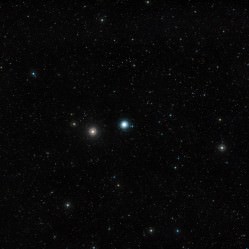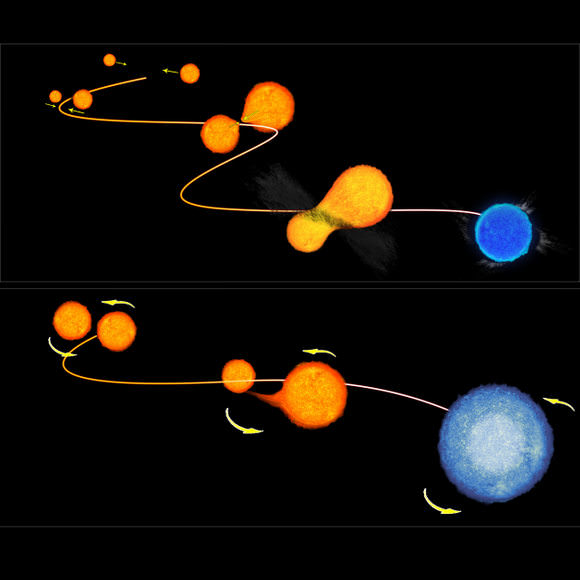Messier 30, from HST’s Advanced Camera for Surveys. Credit: NASA, ESA and Francesco Ferraro (University of Bologna
Blue stragglers are stars that stay on the main sequence longer than expected. They even appear to regress from “old age” back to a hotter and brighter “youth,” gaining a new lease on life in the process. Astronomers have thought blue stragglers were “vampires” that suck fresh hydrogen from companion stars to heat up and maintain their youthfulness. But now there appears to be two kinds of blue stragglers. In addition to the vampires, there are also the bad-boys: these blue stragglers steal mass from companion stars by crashing into their neighbors, as if they were in a stellar mosh pit. A team of astronomers used data from the Hubble Space Telescope to study the blue straggler star content in Messier 30, a swarm of several hundred thousand stars located about 28,000 light-years from Earth.

Blue stragglers have been known since the early 1950s, but how they formed remains an astrophysical puzzle. Of all the stars in Messier 30, which formed about 13 billion years ago, a small fraction of them appeared to be significantly younger.
“It’s like seeing a few kids in a group photo of residents of a retirement home, and ask, ‘How did they get there?'” said Alison Sills, assistant professor at McMaster University. “In short, we seem to have found that there are two fountains of youth for stars.”
Previously, it was thought that that the less massive star in a binary system acts as a “vampire”, siphoning fresh hydrogen from its more massive companion star that allows the smaller star to heat up, growing bluer and hotter. However, the new study shows that some of the blue stragglers have instead been rejuvenated by a sort of “cosmic facelift”, courtesy of cosmic collisions. These stellar encounters are nearly head-on collisions in which the stars actually merge, mixing their nuclear fuel and re-stoking the fires of nuclear fusion. Merged stars and binary systems would both be about twice the typical mass of individual stars in the cluster.

“The observations, which agree with our models, demonstrate that blue stragglers formed by collisions have slightly different properties from those formed by vampirism. This provides a direct demonstration that the two formation scenarios are valid and that they are both operating simultaneously in this cluster,” said Sills, who was part of an international steam that made the findings.
Using data from the now-retired Wide Field Planetary Camera 2 (WFPC2) aboard Hubble, astronomers found that these “straggling” stars are much more concentrated towards the center of the cluster than the average star.
The central regions of high density globular clusters are crowded neighborhoods where interactions between stars are nearly inevitable. Researchers conjecture that one or two billion years ago, Messier 30 underwent a major “core collapse” that started to throw stars towards the centre of the cluster, leading to a rapid increase in the density of stars. This event significantly increased the number of collisions among stars, and favored the formation of one of the families of blue stragglers. On the other hand, the increase of stellar crowding due to the collapse of the core also perturbed the twin systems, encouraging the vampirism phenomenon and thus forming the other family of blue stragglers.
The study will be published in the Dec. 24 issue of Nature.
Sources: ESA Hubble Information, Center, McMaster University University of Wisconsin/Madison


Nah. I still don’t quite believe it.
Blue stragglers can also be caused by such mergers of binaries. These are more likely close contact binaries, which continuously lose their angular momentum by frequent close encounters with other surround stars as they ‘orbit’ within the cluster. From knowledge there are about 10% to a few percent binaries in globulars suggest there are enough to generally explain the population of blue stragglers observed.
The probability of two stars colliding is quite remote compared to their average separation in the globular cluster. If such encounters were to occur, the loss of member from the globulars would be much larger, as encounters would slingshot one (or both) of the stars away from the globular. (If true, based on current theories and simulations, many of the original stars were lost in the first billion years (perhaps up to 80%))
Importantly, any captured star would form a highly elliptical orbit, whose periastron encounters would strip the outer layers of both stars, leaving their hotter cores exposed – the blue stragglers we see. If this were true, we should see relatively hot interstellar gases in globular surround and many X-ray sources. Sadly, observation does not support this at all.
Another general comment is towards authors of articles on blue stragglers. It seems one point is always missed – and that is about the average velocity of the stars in the globular systems. The velocities is normally around 5 km per second, compared to much faster velocities of stars moving in the galactic plane. This means interactions are far more likely for the stars in globular to be captured and form new binary system.
Again the key to blue stragglers is the angular momentum of galactic globular cluster, and of the close binaries (the soft and hard core binaries) which hold these cluster together.
While stellar collisions might be the romantic dreams of the media popularises, the chances of this being a wholly valid explanation of blue stragglers still remain fairly remote, IMO.
According to the relevant paper ( http://www.spacetelescope.org/news/science_paper/heic0918_scipaper.pdf ), it seems possible that both mechanisms for the formation of blue stragglers (stellar mergers and close contact binaries) may have occurred in M 30, though the predominant mechanism is unclear. Mention is made of the recent paper by Knigge et al that proposes that the binary mechanism is dominant (Interestingly, Alison Sills is a coauthor on both papers).
Of the two sequences of blue stragglers in M 30, the so-called red Blue Straggler Stars (Red-BSS) are thought to consist of close contact binaries while the Blue-BSS represent the stellar merger component. Core collapse is invoked as a possible mechanism to explain this curious double sequence of blue stragglers in M 30.
The current paper makes a testable observational prediction that the Red-BSS sequence should be populated by short period binaries. It is noted that the high resolution spectra needed is pushing the limits of current 8m-class telescopes.
I would have to see the physics details here. The only way I can see this working is if there are interactions between compact smaller stars and larger less dense stars. There needs to be lots of dissipation of energy from material flow with friction. Complicated stuff.
LC
This is what I like, real science discussions no EU crap any more. The forums have improved dramatically the last few weeks. .
Are blue-stragglers the only 13 billion year-old blue stars? Hearing that blue stars can be so old was the most surprizing thing to me in the article.
Great image
RUF said;
“Are blue-stragglers the only 13 billion year-old blue stars?”
The blue stragglers are not 13 billion years old and were formed only relatively recently – either from collisions or merging binary stars. (as the article states). Their original progenitors that made the blue stragglers were as old as the cluster when it was formed, somewhere between 10 and 13 billion years ago.
Most star in globulars are smaller than the sun and burn their fuel more slowly and can last much longer. There are no new blue stars in globulars because no nebula gas is available to form stars anymore .
Jon, I read this article too, but the statement;
This IMO is wrong. There are other possible mechanisms. I.e. The merging of stars that are close binaries, whose energy is bleed off by the close encounters but stars moving past them.
I don’t understand why the authors would say such an ambiguous statement. I.e. WHO proposes these ONLY two possibilities?
I know off the cuff several other possibilities which have been stated over the years.
Also the statement quoting a 2009 paper “Recently, the binary explanation was claimed to be dominant.” This is also misleading, as the dominance of binaries to explain this is more than twenty years old! (More than a dozen peer-reviewed articles say this! I.e. van den Bergh, S., Morbey, C., & Pazder, J. ApJ, 375, 594 (1991) and Spitzer, L. Dynamical evolution of globular clusters, ed. L. Spitzer (1989), as examples.)
A better paper, than reference [5] in the original paper of theirs, is Catterjee, S., et.al. “Monte Carlo Simulations of Globular Cluster Evolution. V. Binary Stellar Evolution“. This states that 10% binaries are assumed in the simulations that they did, and back it up with references too.
(Also see Figure 17 (pg.35), which saw a HR Diagram and the placement of single and binary components.
You are bringing up old material on things which are new findings. Even more so… findings which recently have been witnessed, calculated and simulated.
You might as well argue that the Sun revolves around the Earth. I’m sure we can still find papers on it.
More-over. don’t say anything is wrong by bringing up others work. Only claim something to be incorrect if YOU….YOURSELF do the research, and manage to PROVE your words; and then have it independently verified.
Saying someone is wrong the way you are only further displays your ignorance.
BTW… compiling a list of footnotes and references, and then paraphrasing, doesn’t count as research.
Good article… it actually peaked my interest in a couple of things. Something to look forward to on a rainy day!
@ Aodhhan,
Oh such absolute bitterness from someone who obviously knows better than me!
Research by me???? What the heck? I thought this was a news site asking for comment not research and getting my words independently verified. Really. Is this “Universe Today” or the “Astrophysical Journal”?
I just generally question the results and conclusions and not the fact of the collisions may or may not explain the blue stragglers.
I think you should reconsider you opinion here. Facts stated don’t match your somewhat distorted conclusions nor the recent history or investigation into blue stragglers.
I have nothing to prove except encourage further investigation.
The only thing you have shown here is that someone else might know something more than you do. Ignorance? Surely you mean “comprehension”?
Sounds more like sour grapes to me!